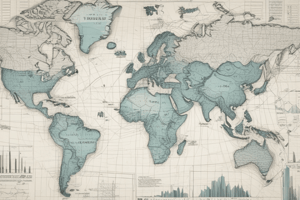Podcast
Questions and Answers
What is uncertainty?
What is uncertainty?
A situation where the current state of knowledge is such that 1) the order or nature of things is unknown, or 2) the consequences, extent, or magnitude of circumstances, conditions, or events is unpredictable.
What are descriptive statistics used for?
What are descriptive statistics used for?
To describe characteristics and responses of groups of subjects.
What is the difference between a population and a sample?
What is the difference between a population and a sample?
A population is all members of a specified group, while a sample is a subset of a population of interest.
What is a population parameter?
What is a population parameter?
What is a sample statistic?
What is a sample statistic?
What kind of data is collected by recording a single characteristic of many subjects at the same point in time?
What kind of data is collected by recording a single characteristic of many subjects at the same point in time?
What kind of data is collected over time?
What kind of data is collected over time?
Structured data is data that has no well-defined length and format.
Structured data is data that has no well-defined length and format.
What is unstructured data?
What is unstructured data?
What is big data?
What is big data?
What is a variable?
What is a variable?
What kind of variable uses labels or names to identify characteristics?
What kind of variable uses labels or names to identify characteristics?
What kind of variable assumes meaningful numerical values?
What kind of variable assumes meaningful numerical values?
What is the difference between a discrete variable and a continuous variable?
What is the difference between a discrete variable and a continuous variable?
What kind of data are values of a qualitative variable that only differ by name or label?
What kind of data are values of a qualitative variable that only differ by name or label?
What kind of data are values of a quantitative variable that can be categorized and ranked, but differences between values are not meaningful?
What kind of data are values of a quantitative variable that can be categorized and ranked, but differences between values are not meaningful?
What kind of data are values of a quantitative variable that can be categorized and ranked, and in which differences between values are meaningful?
What kind of data are values of a quantitative variable that can be categorized and ranked, and in which differences between values are meaningful?
What kind of data are values of a quantitative variable that can be categorized and ranked, and in which differences between values are meaningful and a true 0 point exists?
What kind of data are values of a quantitative variable that can be categorized and ranked, and in which differences between values are meaningful and a true 0 point exists?
Flashcards
Uncertainty
Uncertainty
A situation where the current state of knowledge is such that 1) the order or nature of things is unknown, or 2) the consequences, extent, or magnitude of circumstances, conditions, or events is unpredictable.
Descriptive Statistics
Descriptive Statistics
Statistical procedures used to describe characteristics and responses of groups of subjects.
Inferential Statistics
Inferential Statistics
Statistical methods for drawing conclusions about a population based on a sample.
Population Parameter
Population Parameter
Signup and view all the flashcards
Sample Statistic
Sample Statistic
Signup and view all the flashcards
Cross-Sectional Data
Cross-Sectional Data
Signup and view all the flashcards
Time Series Data
Time Series Data
Signup and view all the flashcards
Structured Data
Structured Data
Signup and view all the flashcards
Unstructured Data
Unstructured Data
Signup and view all the flashcards
Big Data
Big Data
Signup and view all the flashcards
Variable
Variable
Signup and view all the flashcards
Qualitative Variable
Qualitative Variable
Signup and view all the flashcards
Quantitative Variable
Quantitative Variable
Signup and view all the flashcards
Discrete Variable
Discrete Variable
Signup and view all the flashcards
Continuous Variable
Continuous Variable
Signup and view all the flashcards
Nominal Scale Data
Nominal Scale Data
Signup and view all the flashcards
Ordinal Scale Data
Ordinal Scale Data
Signup and view all the flashcards
Interval Scale Data
Interval Scale Data
Signup and view all the flashcards
Ratio Scale Data
Ratio Scale Data
Signup and view all the flashcards
Study Notes
Uncertainty
- Uncertainty is a lack of knowledge about the nature or consequences of events.
- It involves predicting the extent or magnitude of circumstances, conditions, or events.
Descriptive Statistics
- Used to illustrate group characteristics and responses.
Inferential Statistics
- Defines a population as all members of a specific group.
- Identifies a sample as a subset of the population of interest.
Population Parameter
- A characteristic of an entire population.
Sample Statistic
- A variable used to estimate a population parameter.
Cross-Sectional Data
- Data recorded at a single point in time, for a group of subjects
Time Series Data
- Data collected over multiple time periods.
Structured Data
- Data with a defined format and length.
Unstructured Data
- Data not following a row-column format.
Big Data
- Enormous volumes of both structured and unstructured data that are difficult to manage, process, and analyze.
Variable
- A characteristic that varies among observations.
Qualitative Variables
- Use labels or names to distinguish observations.
Quantitative Variables
- Represent observations using numerical values.
Discrete Variables
- Have a countable number of values.
Continuous Variables
- Have uncountable numbers in an interval.
Nominal Scale Data
- Qualitative data categorized by name or label.
- Only categorization is possible.
Ordinal Scale Data
- Quantitative data categorized and ranked.
- Categorization and ranking are possible.
Interval Scale Data
- Quantitative data categorized, ranked, with meaningful differences between values.
Ratio Scale Data
- Quantitative data categorized, ranked, with meaningful differences, and a true zero point.
Studying That Suits You
Use AI to generate personalized quizzes and flashcards to suit your learning preferences.
Description
This quiz covers essential concepts in statistics and data analysis, including uncertainty, descriptive and inferential statistics, and different types of data. Test your understanding of population parameters, sample statistics, and the distinctions between structured and unstructured data. Ideal for students studying statistics or data science.




